► Third Icona model is a mid-engined V12 masterpiece
► Inspired by Ferrari’s sports prototype racers of the 1960s
► Carbon tub, targa roof and the most powerful Ferrari V12 yet
Anyone naively thinking the recent 812 Competizione might be some kind of V12 swansong didn’t have to wait long to be proved wrong. Hot on its heels comes the limited-run Daytona SP3, a stunning tribute to Maranello’s sports car racing glories of the 1960s and its first mid-engined V12 since the hybrid LaFerrari. Offered only to Ferrari’s most loyal clients, the SP3 follows the SP1 and SP2 Monza barchettas as the third Icona model.
Ferrari Daytona SP3 review: we drive the most powerful roadgoing Ferrari of all time
At 2 million euros it is the most expensive Icona yet. It’ll also be built in greater numbers (599 units versus 499 for the Monza) because its global road legality (the windscreen-less Monzas were impossible to homologate in some territories) opens it up to more clients. Deliveries will begin in late 2022 (the last Monza cars are being built now; the SP3 will use the same line), with production continuing through 2023 to 2024.
All 599 are already spoken for, but there’s hope – Ferrari has confirmed the Icona series is here to stay. All will be design-led riffs on the most vibrant and emotive chapters in Maranello’s almost uniquely evocative history, or ‘drawn from the past while remaining visionary’, as chief design officer Flavio Manzoni eloquently puts it.
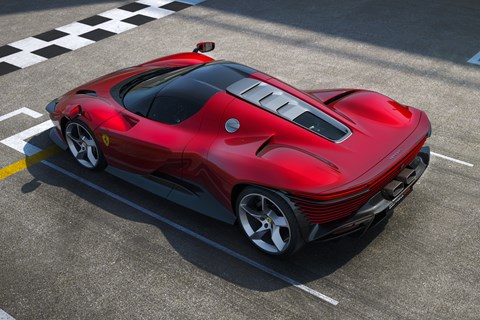
They’ll also exist purely to capture the heart and the imagination of Ferrari superfans, and it’ll be left to the likes of the LaFerrari and its successors to introduce new technology and chase outright performance. Ferrari admits that, because its supercars are so technically demanding and their performance targets so ambitious, engineering must ultimately get the casting vote over design in times of conflict – the Icona cars are permitted a reversal of that philosophy.
What lies beneath?
Structurally the Daytona uses a modified version of the LaFerrari Aperta’s composite monocoque, though the SP3 goes without that car’s hybrid elements, saving a little weight in the process (the Daytona comes in at 1485kg dry, split 44:56 front/rear). It also uses only passive aerodynamic solutions – active flaps just wouldn’t be right on a car with its heart and soul in the 1960s.
The SP3’s pursuit of all that is pure and analogue does not extend to a manual gearbox, though. ‘It’s important to say that just because this is a pure car, it is not a nostalgic car,’ explains chief technical officer Michael Leiters. ‘There is still technology on it. To make a manual gearbox is nostalgic.’
Oh. My. God. Look at it!
Pretty, no? If further evidence was required that Manzoni and his Centro Stile team are quite good at their job, along comes the most beautiful mid-engined Ferrari since the LaFerrari.
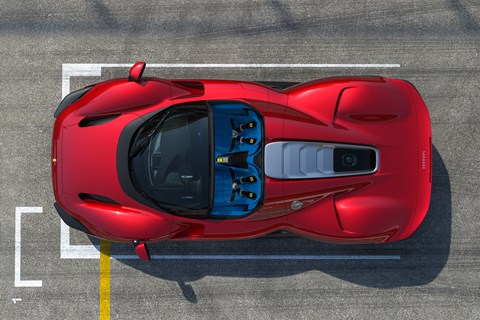
Inspired by the likes of the incomparably pretty 330 P4 (the curving musculature over each wheel and the sleek central cockpit) and the brutally beautiful 512 S (the dramatic slab-sided ‘pods’ just ahead of the doors), the Daytona SP3 is a labour of love and a design tour de force, one that revels in the interplay of curvaceous and geometric forms. Low and wide, with a dramatically pinched waist and cab-forward proportions, the car’s reputed to have moved at least one of its owners-in-waiting to tears of joy.

The more you look at it, the more you see: the dramatic slatted elements front and rear (the rear end is entirely open, for heat evacuation from the engine bay, but the slats make it appear solid, almost sculptural – it’s Manzoni’s favourite detail); the low-drag mirrors out on the front wheel arches like a ’60s sports prototype; ducts for the rear wing and mid-mounted radiators (engine oil one side, gearbox and clutch oil the other, with the main radiator in the nose) that run right through the butterfly doors; and motorised ‘eyelids’ that move to expose the headlights’ high-beam elements. The vast rear clamshell (all the bodywork is carbonfibre), with its pronounced dorsal spine, is also a work of art – one even Maranello’s gifted engineering team had to suffer for.
Talk to me about the V12
Appropriately, given the cars that inspired it boasted 12-cylinder engines, the SP3 is powered by a mid-mounted V12. And it’s not just any old V12. It is nothing less than the most powerful V12 Ferrari has ever built: 829bhp, a 9500rpm rev ceiling and 514lb ft of torque.
Dubbed F140HC, it’s a mid-engined variation on the 812 Competizione’s F140HB, and as such remains a 6.5-litre V12 with its cylinder banks splayed at 65°. That same 9500rpm rev ceiling is the result of painstaking internal work: low-friction DLC treatments; titanium rods; a rebalanced crank 3% lighter than the 812 Superfast’s; and a lightweight, rev-happy finger-follower valvetrain. New inlet and exhaust systems account for the SP3’s power advantage over the Competizione.
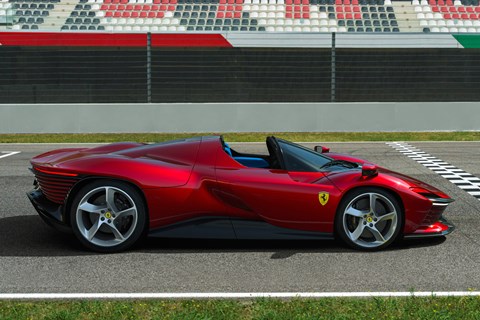
Ditching the hybrid powertrain hasn’t just saved weight. The space the LaFerrari’s e-motor occupied on the back of the gearbox has been given over to the majestic induction system. And the space previously occupied by the hybrid battery is occupied by two so-called ‘chimneys’ that evacuate air from under the body and flow it onto the rear wing – just one of the reasons Maranello is claiming this as its most aerodynamically efficient passive-aero car to date, one capable of generating a useful 230kg of downforce at 124mph.
Just as the design references on the past without copying it, so the same is true of the SP3’s performance. You might sit low like a sports car-racing hero, arms out straight, face set in a study of determination, but there’s nothing retro about the Daytona SP3’s numbers: 0-62mph in 2.85sec, 0-124mph in 7.4sec and a top speed in excess of 211mph.
What’s it like inside?
Pretty knockout. The seats are integrated into the carbonfibre chassis structure, an approach Ferrari used on the LaFerrari with numerous benefits: a lower car and centre of gravity, reduced weight and a suitably purposeful, reclined driving position (an adjustable pedal box accommodates drivers of different heights).
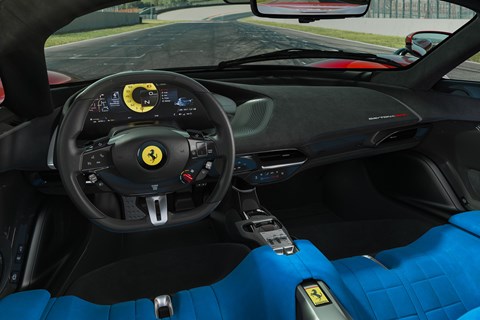
Like the sports prototypes that inspired it, textiles and padding blur the lines between the seats and the structure that contains them, with continuous theme lines running around the space to give the impression of a true cockpit, whether the targa roof’s in place or – better still – removed.
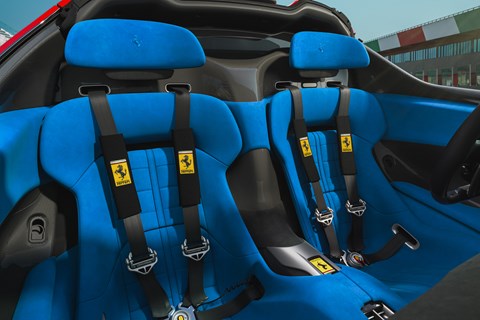
A split-level dash appears to float on a single central carbonfibre pillar. Ferrari’s new-generation infotainment system features, as do its very latest driver-assist electronics, including Side Slip Control 6.1 (making its debut on a mid-engined V12) and Ferrari’s Dynamic Enhancer, as well as the now familiar drive mode manettino.
Take my money!
Like we said, too late. Next time, my friend. Next time.